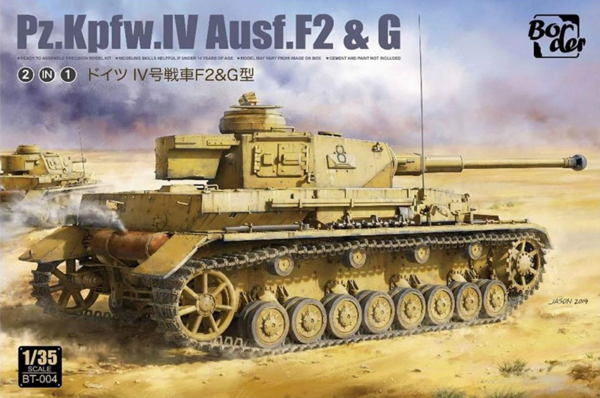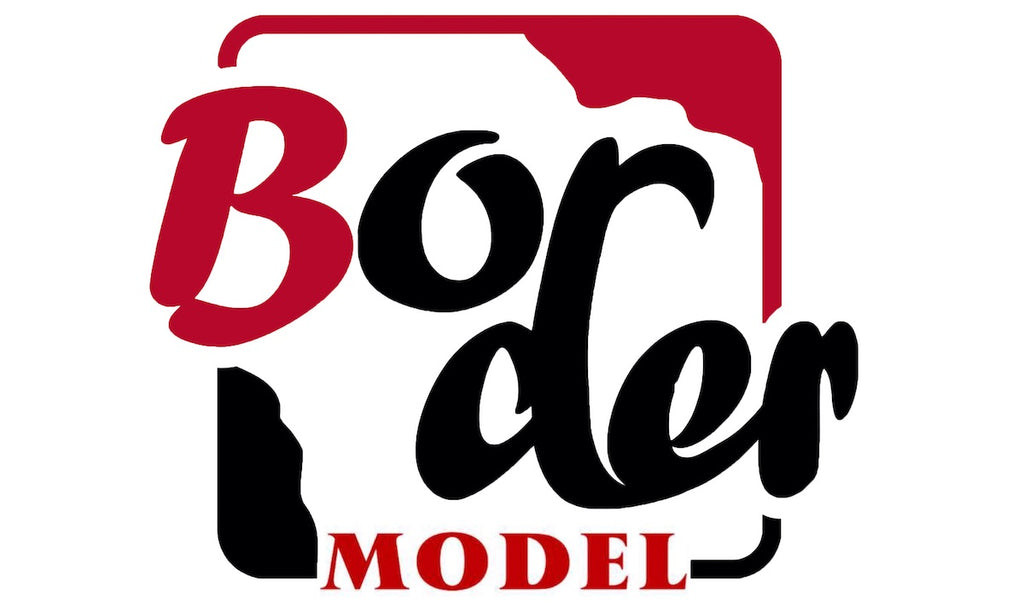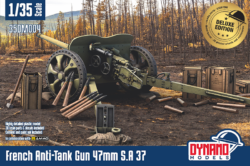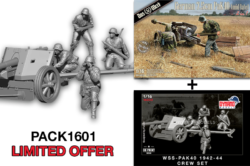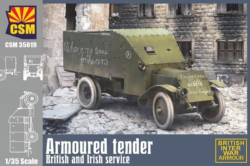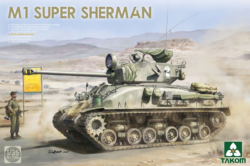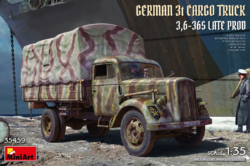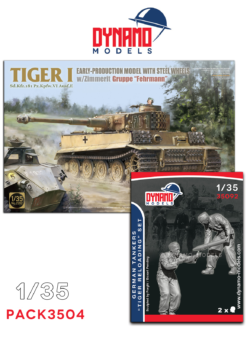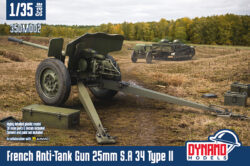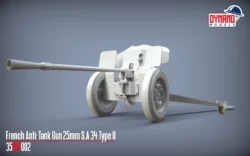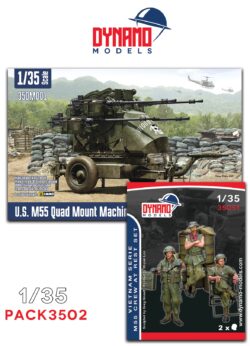Border Model BT004 – Pz.Kpfw. IV Ausf. F2 & G 2 in 1
48,00€
– Plastic model kit to build a Pz.Kpfw.IV Ausf. F2 & G 2 in 1 1/35 by Border Model.
– Scale plastic kit include photo-etch, clear parts and decals
– Model to be assembled and painted. Glue and paint not supplied.
1 en stock
Key Features:
- Dual Build Option (2-in-1): This kit allows you to build either the Ausf. F2 or Ausf. G version, offering flexibility to modelers who may want to recreate specific Panzer IV variants.
- Highly Detailed 7.5cm KwK 40 L/43 Gun: The kit features an accurate long-barrel 7.5cm main gun with detailed mantlet and muzzle brake, capturing the distinctive firepower of the Ausf. F2 and G variants. The gun can be positioned at different angles, adding display flexibility.
- Photo-Etched (PE) Parts: Includes PE parts for fine details such as engine grilles, fender supports, and additional armor plates, which add authenticity to the tank’s appearance.
- Individual Track Links: The kit includes individual track links, allowing for natural track sag and precise fit around the suspension. This feature enhances the model’s realism, especially in diorama settings.
- Detailed Suspension and Road Wheels: The suspension is meticulously detailed, with realistic road wheels, drive sprockets, and idlers that capture the Panzer IV’s structure.
- Clear Parts for Periscopes and Vision Ports: The model includes clear plastic parts for the periscopes and vision ports, enhancing the appearance of these components and adding depth to the finished model.
- Open or Closed Hatches: The kit provides options for modeling hatches in either the open or closed position, enabling additional customization and the option to add crew figures.
- Multiple Marking and Decal Options: The kit includes a variety of decals for different units and theaters, allowing modelers to accurately depict either version in various historical contexts.
- Optional Schürzen (Side Armor Skirts): The Panzer IV Ausf. G introduced side skirts for additional protection, and this kit includes optional side armor skirts (Schürzen), allowing modelers to choose how they want to configure the tank.
- Detailed Turret and Interior Elements: Border Model has paid special attention to the turret’s detail, with finely molded parts for the turret hatches, gun breech, and interior details, enhancing the tank’s overall accuracy.
- Accessory Options: The kit comes with additional stowage and equipment, such as jerry cans, spare track links, and tools, giving modelers options to personalize the vehicle’s appearance.
The Border Model BT-004 Pz.Kpfw. IV Ausf. F2 & G 2-in-1 is an excellent kit for WWII armor enthusiasts who want the flexibility to build either the F2 or G variant of the Panzer IV. With its detailed parts, customizable options, and historical accuracy, this model captures the Panzer IV’s versatility and effectiveness on the battlefield.
Panzer IV Ausf. F2:
The Panzer IV Ausf. F2 was a pivotal upgrade in the German Panzer IV series, transitioning this widely produced tank from a support role to an effective tank destroyer capable of engaging Allied armor on more equal terms. Introduced in 1942, the Ausf. F2, also known as the “long-barreled Panzer IV,” featured the formidable 7.5 cm KwK 40 L/43 cannon, which gave it significantly improved anti-tank capabilities compared to its predecessors.
Design and Armament
The Panzer IV Ausf. F2 retained the same basic chassis and hull design as earlier Panzer IV variants, powered by the Maybach HL120 TRM engine, which provided 300 horsepower. This engine allowed the tank to reach a top speed of approximately 40 km/h on roads and maintain steady mobility in rough terrain, making it suitable for versatile battlefield roles. However, the defining feature of the Ausf. F2 was its new, longer 7.5 cm KwK 40 L/43 main gun, which offered vastly improved firepower over the shorter KwK 37 L/24 gun used in previous Panzer IV models.
The KwK 40 gun had a high muzzle velocity, allowing it to penetrate up to 89 mm of armor at 1,000 meters, sufficient to engage and destroy Soviet T-34s and American M4 Shermans, which were becoming more prevalent on the battlefield. This increase in firepower transformed the Panzer IV from an infantry support vehicle to a competent tank killer. The addition of a muzzle brake to the gun helped absorb recoil, enhancing the tank’s stability when firing. The Panzer IV Ausf. F2 was also equipped with a coaxial 7.92 mm MG34 machine gun and a secondary MG34 mounted in the hull, providing it with anti-infantry capability.
Armor and Survivability
The Panzer IV Ausf. F2 featured modest armor improvements over earlier variants, with 50 mm of frontal armor on the hull and turret, offering increased protection but remaining vulnerable to high-velocity anti-tank guns and larger Allied tanks. The tank’s side armor, at 30 mm, provided basic protection against small arms and shrapnel but was still susceptible to most anti-tank weapons from the side and rear. While not heavily armored by 1942 standards, the Ausf. F2’s mobility and firepower allowed it to perform effectively when employed with support and proper tactical positioning.
Operational Role and Legacy
The introduction of the Panzer IV Ausf. F2 marked a turning point in the German armored forces, as it allowed them to more effectively counter the new generation of Allied and Soviet tanks. The F2 proved highly effective on the Eastern Front, where its ability to penetrate T-34 armor made it a valuable asset to German armored divisions. This version of the Panzer IV was later redesignated as the Ausf. G, a testament to its influence on subsequent models in the Panzer IV line.
The Panzer IV Ausf. F2’s successful adaptation of a longer, more powerful gun laid the groundwork for German tank evolution, setting the stage for even more heavily armed and armored vehicles. Its role in WWII as a versatile and reliable workhorse made the Panzer IV a mainstay of the German armored forces, and the F2 version in particular was a key contributor to the tank’s continued effectiveness against increasingly capable Allied armor.
| Poids | 0,8 kg |
|---|---|
| Brand | |
| Country |
Germany |
| Material |
Plastic |
| Period |
WW2 |
| Scale |

